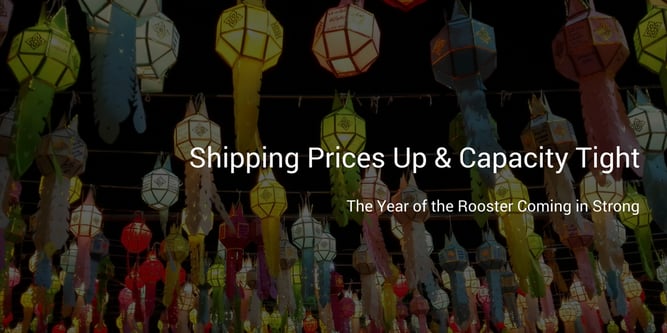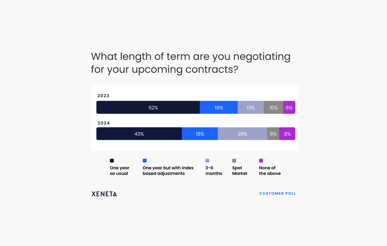
Chinese New Year, starting this year on January 28th, is a time in which most of Asia’s manufacturing facilities close for one to three weeks. Ahead of this period, however, businesses rush to import goods from Asia often in the midst of higher rates and tight capacity. In this week’s survey, we asked our community if they are experiencing higher rates and tight capacity leading up to the Chinese New Year.
Rising Container Rates and Tight Capacity
The results of our survey were a resounding "yes" with 80% of those surveyed indicating that they are in fact experiencing higher rates and tight capacity while 20% of survey respondents voted "no".
Data from the Xeneta platform today reports ocean freight spot rates to both the East and West Coasts of the US were on average 37% higher than they were in late December 2016. Although not as high as on the trans-Pacific, the Asia-Europe route has also reported high spot rates since late December with an increase of approximately 10%.
Jump in US Imports
Container cargo imports jumped during the final weeks of 2016, as retailers stocked up on inventory heading into the New Year. According to research firm Panjiva, which tracks trade data, U.S.-bound seaborne shipments increased 8.9% in December over the same month a year earlier.
Strong holiday sales ended 2016 on a positive note for retailers as expectations for 2017 have only increased further. The period between the holiday season and the Chinese New Year is a short one this year, so it comes as no surprise that ocean freight rates have remained elevated.
Still to be Seen
Most industry analysts do not expect ocean freight rates to maintain their current levels after the Chinese New Year celebration. An interesting commentary is from Jock O’Connell, a trade economist, who said that shippers may be stocking up on inventory now in case rates rise this spring. It is possible that rates could rise as ocean freight alliances prepare to begin services in April but it remains unknown what the alliances may bring.
Our CEO, Patrik Berglund, said in our recent shipping rates webinar:
“I think it's key to keep an eye on how the short-term market develops post Chinese New Year because if, as we've seen historically, it plummets quickly after that then it might very well rapidly change from a seller's to a buyer's market again. If it sticks, the shippers sitting on the fence, waiting for Chinese New Year to blow over, they might have lost out on the opportunity to contract, as they've done historically, according to the calendar year for Europe and then, as quickly as possible, for the trans Pacific corridor.”
Shipping Rates on the Rise | Have the Upper Hand
Ocean freight rates are increasing, and as said, it remains to be seen how they will fare after Chinese New Year. Find out how to stay ahead of the market to make sure your freight prices are competitive and cargo flow uninterrupted.
Download our webinar, where we review shipping rates for the main global routes and you'll get answers to questions like:
- What should you be on the lookout for during your 2017 ocean freight negotiations?
- What was the price activity like for the spot market in Q4 2016 for Asia-N.Europe and Asia - North America West Coast and how are long-term rates behaving?
- Should shippers continue to wait out contract negotiations or is it getting risky?
Related reading
[SURVEY SAYS] How Efficient Are Your Supply Chains?
[SURVEY SAYS] Supply Chain Hiccups: Manual or Automated Intervention?
How Often Do You Negotiate Ocean Freight Rates?
[SURVEY SAYS] When Will Ocean Freight Rates Return to Profitability
%201.png)


-1.jpg)



